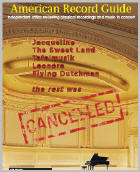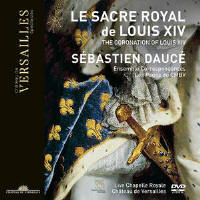Reviewer: Charles
Brewer
Following the death of his
father, Louis XIII, Louis Dieudonné de Bourbon was crowned King of France in
Rheims Cathedral on 7 June 1654, hence the French title for this release:
"Le Sacre Royal de Louis XIV". While external evidence is preserved
concerning the ceremony, there is no indication of what specific music was
performed. With the assistance of musicologist Thomas Leconte, Sebastien
Daucé has prepared a hypothetical reconstruction of music for this ceremony
based on printed and manuscript sources from the early 17th Century. This
was filmed in concert at the Chapel of Versailles. Daucé's project joins a
growing list of reconstructions for other historical ceremonies, such as the
musical recreations of the coronation of Elizabeth I by Philip Cave (Griffin
4032), the state funeral for Admiral Lord Nelson by David Price (Herald
802322), or the recent video recording of the music for the Coronation of
George II, including Handel's Coronation Anthems, also filmed in the Chapel
at Versailles (July/Aug 2019).
Given the importance of Louis XIV's coronation, the sources
apparently supply some clues as to the musicians and instruments that would
have participated; and Daucé has gather a large and varied ensemble of
singers (both adults and the children of "Les Pages du Centre de musique
baroque de Versailles") and instrumentalists, including consorts of
recorders, shawms, cornetti, and sackbuts, a "basse de Lorraine" (a bass
string instrument between a cello and double bass in size), and even a
serpent, along with a 17-member string ensemble. The musical selections come
from a wide variety of sources, including royal musicians such as Antoine
Boesset, Etienne Moulinié, and Henry Du Mont, a Mass setting by Charles
D'Helfer, and a 'Dixit Dominus' and 'Sonata a 12' by Francesco Cavalli,
along with many anonymous works found in the so-called Deslauriers and Tours
manuscripts. The chant is fascinating because some of the Latin texts have
been modified to include references to the Bourbon dynasty or Louis himself.
The instrumental marches and dances are taken from a retrospective
collection of instrumental music from the reign of Louis XIII copied in
1690, including a Pavane for his coronation. Previous reviewers of the
series of concert videos from the Chapel at Versailles have noted the
wandering eye of the camera, but in this concert, the visual images of the
unusual instruments is matched by the movement of the musicians themselves.
The concert begins with all the musicians marching into the chapel
(including the lower strings, who use carrying straps). The musical
requirements change from piece to piece; for example, the chant can be seen
sung by the adult singers on the platform or by Les Pages from the gallery
or even in the midst of the audience. Musicians shift from the stage to
platforms on either side of the hall for the polychoral pieces or even up to
the gallery for a motet for solo soprano and continuo by Henry Du Mont ('In
lectulo meo') with an "echo" soprano and theorbo up in the gallery above the
stage. Certainly in contrast to the recent Messiah recording from the
same place (M/J 2020: 188), where Mr Gatens noted that "there is some degree
of contrivance in a DVD of an event that is not essentially visual", Daucé
and his visual directors, Mickaël Phelippeau and Marcela Santander, have
created a concert that gains a great deal through being seen.
In sum, this is a fascinating visual and aural document with subtitles for
all of the vocal music. The audio quality is excellent; I noticed at one
point in the mix, even when most of the ensemble was performing, you could
also distinguish the single recorder player who was doubling one of the
soprano parts. You can also see and hear a very elegant performance of chant
accompanied by an also elegant "serpentist", Patrick Wibart. Add to that the
rarely performed early 17th Century French sacred repertoire, and
this is certainly worth having.
Fermer la fenêtre/Close window
|




